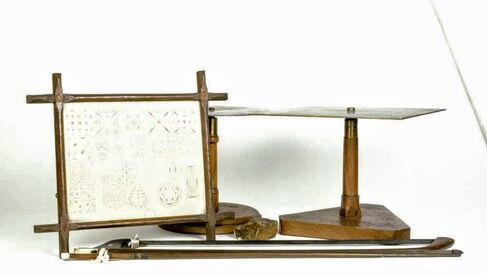Ernst Chladni: Physicist, Musician and Musical Instrument Maker

The Whipple Museum's collection includes scientific instruments, apparatus, models, pictures, prints, photographs, books and other material related to the history of science. Find our more about the history of our building and the founding of the museum in this section.
The Museum and its collection
The museum's holdings are particularly strong in material dating from the 17th to the 19th centuries, especially objects produced by English instrument makers, although the collection contains objects dating from the medieval period to the present day. Instruments of astronomy, navigation, surveying, drawing and calculating are well represented, as are sundials, mathematical instruments and early electrical apparatus.
The Whipple Museum was founded in 1944 when Robert Stewart Whipple presented his collection of scientific instruments to the University of Cambridge.
Since Robert Whipple's initial gift of the collection, the Museum has come to house many instruments formerly used in the Colleges and Departments of the University of Cambridge. Find out more about these on the Special Collections page.
Ernst Chladni (1756-1827) is regarded by many historians as the 'father of acoustics' for his seminal experimental work on vibrations. He was also a well respected musician and inventor of musical instruments.
Early life
Ernst Chladni (image 1) was born in Wittenberg, Germany. Chladni's father, who was a professor of law at the University of Wittenberg, disapproved of his son's early interests in music and science and forced him to study law. Chladni duly obtained a law degree from the University of Leipzig in 1782. In the same year, following the death of his father, Chladni found himself free to pursue his interests in music and science, which he did with remarkable success.
Acoustical work
Chladni is best known for his work in acoustics, and for his invention of a method for visualizing the patterns of vibrations on mechanical surfaces. The Whipple has two examples of 'Chladni plates' - metal plates that can be caused to vibrate using a violin bow. Building on pioneering work done by Robert Hooke (1635-1703) in Oxford during the late 17th century, Chladni revealed the patterns of vibration using fine sand, which settles into the nodal lines (areas of zero displacement) producing striking and beautiful shapes. Chladni's demonstrations attracted the interest of the French Emperor, and amateur scientist, Napoleon Bonaparte (1769-1821) who was so impressed that he financed the translation of Chladni's major work Die Akustic into French, which appeared in 1809 (image 2).
Chladni also conducted some of the first research into tuning forks, paving the way for the perfection of these implements as musical and scientific instruments. This study was the technical groundwork for his best known musical instrument, the clavicylinder. This keyboard instrument worked using resonating metal bars, like tuning forks, which were pressed against a rotating felt-covered friction wheel. Chladni spent many years touring Europe giving performances of popular works by famous composers. The instrument enjoyed widespread acclaim, but unfortunately for Chladni it never caught on as a serious orchestral instrument, being outshone by Benjamin Franklin's (1706-1790) glass armonica.
Chladni plates: the first step towards visualizing sound
Chladni plates, invented by the physicist, musician and musical instrument maker Ernst Chladni (1756-1827) in the late 18th century, are used to demonstrate the complex patterns of standing wave vibrations that can occur in two-dimensional objects. The Whipple's collection contains two examples from King's college London, made and used in the laboratory of the physicist Sir Charles Wheatstone (1802-1875).
How they work
The Whipple's plates are made of iron and are caused to vibrate by stroking with a violin bow. When stroked, a given plate will resonate at one of its natural frequencies. The experimenter then sprinkles fine sand, which bounces about on the plate until settling at nodal points (areas of zero movement) thereby producing intricate patterns such as the one shown in image 3. This technique of visualisation was invented by Chladni and documented in his book Die Akustic (published 1802).
Theoretically, any plate has indefinitely many possible vibration modes each corresponding to a specific frequency of sound. Each mode produces a unique pattern, the complexity of which increases with the frequency of the vibration. The shape of the patterns produced on a given plate depends on other factors, including the shape of the plate itself. One can get a sense of the variety of possible patterns from the accompanying illustration from Chladni's book (image 4).
Musical use
Chladni plates have been used for serious research and are instructive as learning tools, but modern researchers are interested in the vibrational behaviour of more than just sheets of iron. Stringed musical instruments like the violin and the guitar rely on the resonance of their wooden bodies to amplify and colour the sounds produced by their vibrating strings. Chladni's methods can be applied to violin and guitar bodies and used by instrument builders to 'tune' the resonances of the instrument. Image 5 shows professor Jim Woodhouse of the Cambridge University Engineering Department demonstrating Chladni patterns on a violin back plate.
Meteoritics
Chladni is also notable for his pioneering work on meteorites. In 1794 he was the first to propose that meteorites have their origins in outer space - a claim which initially attracted ridicule. His opponents favored a theory connecting meteorites to volcanic activity, but he was later vindicated by the work of Jean Baptiste Biot (1774-1862) in 1803.
Torben Rees
Torben Rees, 'Ernst Chladni: physicist, musician and musical instrument maker', Explore Whipple Collections, Whipple Museum of the History of Science, University of Cambridge, 2009
